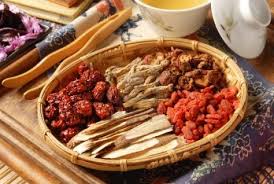 The sustained use of Chinese herbs is highly effective, cost effective, and has little to no side effects. Herbs are also good for health maintenance and building up the immune system.
There are more than 5,000 varieties of Chinese herb specimens in clinical practice. Over 90% are plants, including the roots, stems, leaves, flowers, fruits, barks and peels. Chinese herbs have four properties (cold, hot, warm, and cool) and five tastes (pungent, sweet, sour, bitter and salty). Herbs’ properties and tastes are classified according to their therapeutic effects. These substances also have different functions, which refer to the directions of herbal action: ascending and descending, floating and sinking. The ascending and floating herbs have an upward and outward effect and are used for activating vitality, inducing sweats, and dispelling exogenous pathogens. The descending and sinking herbs have downward and inward effects, are used for tranquillizing, causing contractions and so on.
Herbs are handled and processed in different ways including steaming, roasting, baking, annealing, rinsing, soaking and boiling to achieve different results. For example, steaming rhubarb with wine may enhance its blood-moving function. Charcoaled rhubarb can be used for internal bleeding. The complex handling and processing help to reduce or eliminate toxicity and side-effects of herbs.
Herbal formulas, a combination of single herbs in a prescription, are commonly used. A prepared formula can have two, three, or as many as a dozen of ingredients. Prescriptions of different compositions and doses are used to treat various diseases. For example, ephedra can treat common colds if it is mixed with cinnamon stem, and can treat asthma if it is prepared with bitter almond and gypsum. Nowadays, many herbs can be obtained in the form of tablets, granules, capsules and injections (for convenience) and in bulk for home brewing (the traditional way of preparation).
The sustained use of Chinese herbs is highly effective, cost effective, and has little to no side effects. Herbs are also good for health maintenance and building up the immune system.
There are more than 5,000 varieties of Chinese herb specimens in clinical practice. Over 90% are plants, including the roots, stems, leaves, flowers, fruits, barks and peels. Chinese herbs have four properties (cold, hot, warm, and cool) and five tastes (pungent, sweet, sour, bitter and salty). Herbs’ properties and tastes are classified according to their therapeutic effects. These substances also have different functions, which refer to the directions of herbal action: ascending and descending, floating and sinking. The ascending and floating herbs have an upward and outward effect and are used for activating vitality, inducing sweats, and dispelling exogenous pathogens. The descending and sinking herbs have downward and inward effects, are used for tranquillizing, causing contractions and so on.
Herbs are handled and processed in different ways including steaming, roasting, baking, annealing, rinsing, soaking and boiling to achieve different results. For example, steaming rhubarb with wine may enhance its blood-moving function. Charcoaled rhubarb can be used for internal bleeding. The complex handling and processing help to reduce or eliminate toxicity and side-effects of herbs.
Herbal formulas, a combination of single herbs in a prescription, are commonly used. A prepared formula can have two, three, or as many as a dozen of ingredients. Prescriptions of different compositions and doses are used to treat various diseases. For example, ephedra can treat common colds if it is mixed with cinnamon stem, and can treat asthma if it is prepared with bitter almond and gypsum. Nowadays, many herbs can be obtained in the form of tablets, granules, capsules and injections (for convenience) and in bulk for home brewing (the traditional way of preparation).
